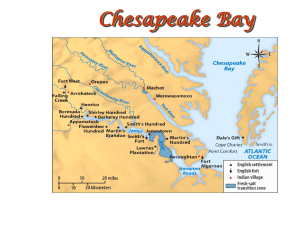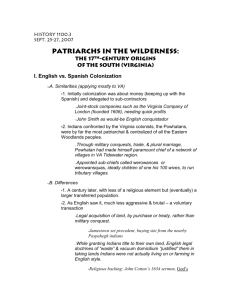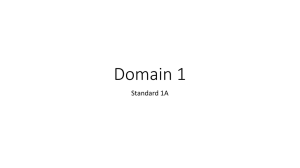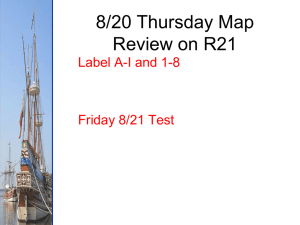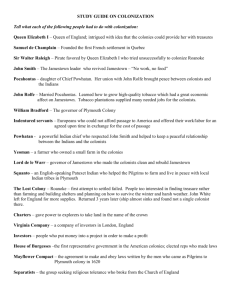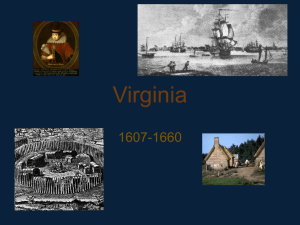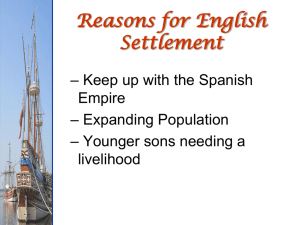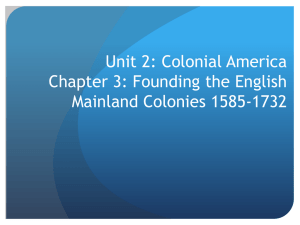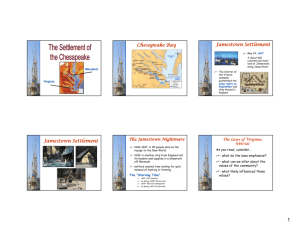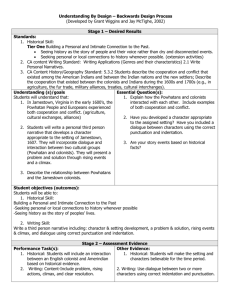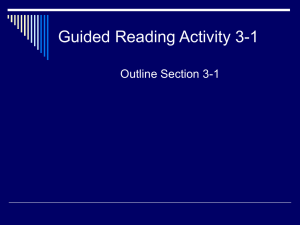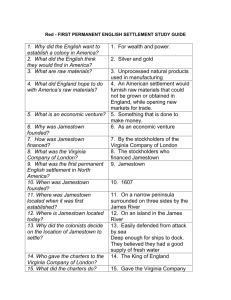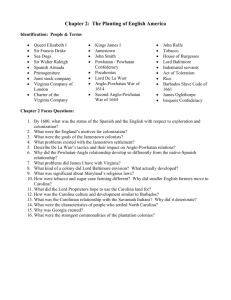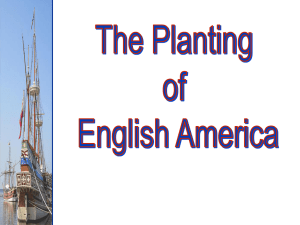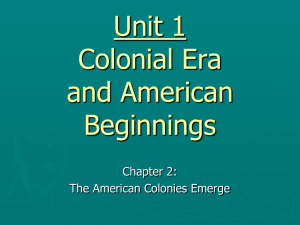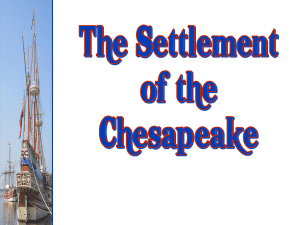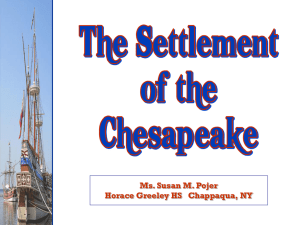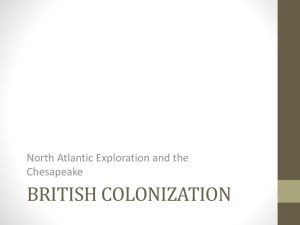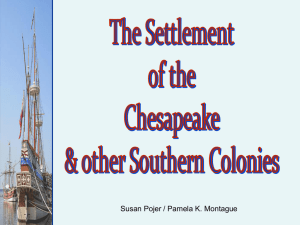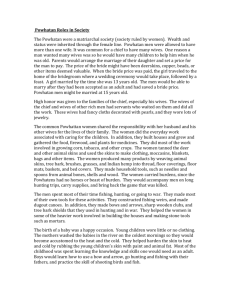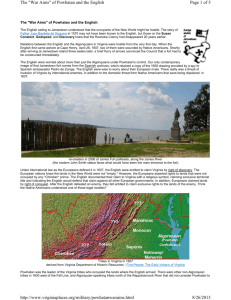Chesapeake Colonization - Warren Hills Regional School District
advertisement
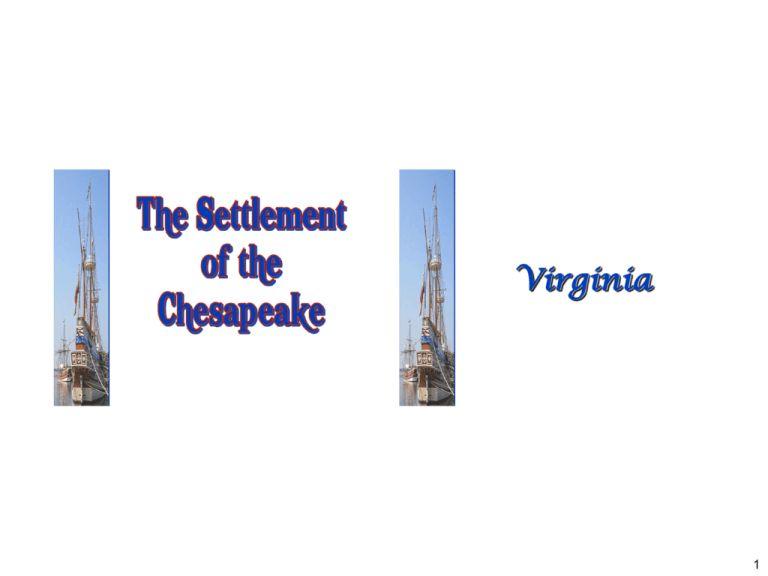
Virginia 1 English Colonization The Charter of the Virginia Company: Guaranteed to colonists the same rights as Englishmen as if they had stayed in England. This provision was incorporated into future charters. Colonists felt that, even in the Americas, they had the rights of Englishmen! England Plants the Jamestown “Seedling” Late 1606 VA Co. sends out 3 ships Spring 1607 land at mouth of Chesapeake Bay. May 24, 1607 about 100 colonists [all men] land at Jamestown, along banks of James River Easily defended, but swarming with disease-causing mosquitoes and sometimes stagnant water. 2 02.01.jpg 3 Chesapeake Bay Jamestown Fort & Settlement Map 4 Jamestown Fort & Settlement Jamestown Housing (Computer Generated) 5 Jamestown Settlement Problems at Jamestown 6 The Jamestown Nightmare 1606-1607 40 people died on the voyage to the New World. Captain John Smith: The Right Man for the Job?? 1609 another ship from England lost its leaders and supplies in a shipwreck off Bermuda. Settlers died by the dozens! ―Gentlemen‖ colonists were unable to fend for themselves. Game in forests & fish in river uncaught. Assumed the natives would help. 7 High Mortality Rates The ―Starving Time‖: 1607: 104 colonists By spring, 1608: 38 survived 1609: 300 more immigrants By spring, 1610: 60 survived 1610 – 1624: 10,000 immigrants 1624 population: 1,200 Adult life expectancy: 40 years Death of children before age 5: 80% Chief Powhatan Powhatan Confederacy Powhatan dominated a few dozen small tribes in the James River area when the English arrived. The English called all Indians in the area Powhatans. Powhatan probably saw the English as allies in his struggles to control other Indian tribes in the region. 8 Chief Powhatan Powhatan Confederacy 9 Powhatan Indian Village Culture Clash in the Chesapeake Relations between Indians & settlers grew worse. English raided Indian food supplies during the starving times. 1610-1614 First Anglo-Powhatan War Raided villages, burned houses, took supplies, burned cornfields. 10 Culture Clash in the Chesapeake Powhatan Uprising of 1622 1614-1622 peace between Powhatans and the English. 1614 peace sealed by the marriage of Pocahontas to Englishman John Rolfe. 1622-1644 periodic attacks between Indians and settlers. 1622 Indians attacked the English, killing 347 [including John Rolfe]. Virginia Co. called for a ―perpetual war‖ against the Native Americans. Raids reduced native population and drove them further westward. 11 Culture Clash in the Chesapeake Pocahontas – A Coda 1644-1646 Second Anglo-Powhatan War Last effort of natives to defeat English. Indians defeated again. Peace Treaty of 1646 Removed the Powhatans from their original land. Formally separated Indian and English settlement areas! Write down 3 things you learn from this video? 12 John Rolfe English Migration: 1610-1660 What finally made the colony prosperous?? 13 Tobacco Plant Early Colonial Tobacco 1618 — Virginia produces 20,000 pounds of tobacco. 1622 — Despite losing nearly one-third of its colonists in an Indian attack, Virginia produces 60,000 pounds of tobacco. 1627 — Virginia produces 500,000 pounds of tobacco. Virginia’s gold and silver. -- John Rolfe, 1612 1629 — Virginia produces 1,500,000 pounds of tobacco. 14 Indentured Servitude Headright System: Each Virginian got 50 acres for each person whose passage they paid. Indenture Contract: 5-7 years. Promised ―freedom dues‖ [land, £] Forbidden to marry. 1610-1614: only 1 in 10 outlived their indentured contracts! Virginia: “Child of Tobacco” Tobacco’s effect on Virginia’s economy: Vital role in putting VA on a firm economic footing. Ruinous to soil when continuously planted. Chained VA’s economy to a single crop. Tobacco promoted the use of the plantation system. Need for cheap, abundant labor. 15 River Settlement Pattern Large plantations [>100 acres]. Widely spread apart [>5 miles]. 16

